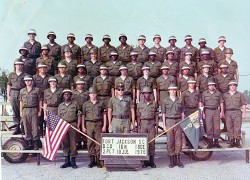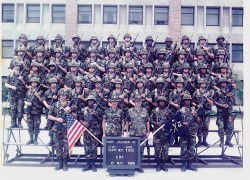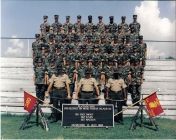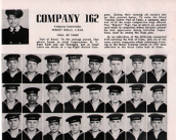A Cannon Crewmember is an important part of the Army's success on the battlefield. Artillery teams are used to support infantry and tank units in combat, but also have responsibilities during peacetime. Cannon Crewmembers work on cannons known as 'howitzers,' a heavy artillery machine piece with single-barrel firing capability.
13B1O - Skill Level One




Assistant Gunner: Integral member of a crew that operates high technology cannon artillery weapon systems. Loads and fires howitzers. Sets fuse and charge on a variety of munitions, including high explosive artillery rounds, guided projectiles, scatterable mines, and rocket assisted projectiles. Uses computer generated fire direction data to set elevation of cannon tube for loading and firing. Employs rifles, machine guns, and grenade and rocket launchers in offensive and defensive operations. Communicates using voice and digital wire and radio equipment. Uses critical combat survival skills to operate in a hostile environment. Maintains operational readiness of vehicles and equipment.
Cannoneer: Integral member of a crew that operates high technology cannon artillery weapon systems. Loads and fires howitzers. Sets fuse and charge on a variety of munitions, including high explosive artillery rounds, laser guided projectiles, scatterable mines, and rocket assisted projectiles. Uses computer generated fire direction data to set elevation of cannon tube for loading and firing. Employs rifles, machine guns, and grenade and rocket launchers in offensive and defensive operations. Drives and operates heavy and light wheeled trucks and tracked vehicles. Transports and manages artillery ammunition. Participates in reconnaissance operations to include security operations and position preparation. Operates in reduced visibility environments with infrared and starlight enhancing night vision devices and other equipment. Coordinates movement into position. Camouflages position area. Communicates using voice and digital wire and radio equipment. Uses critical combat survival skills to operate in a hostile environment. Maintains operational readiness of vehicles and equipment.
Cannoneer: Integral member of a crew that operates high technology cannon artillery weapon systems. Loads and fires howitzers. Sets fuse and charge on a variety of munitions, including high explosive artillery rounds, laser guided projectiles, scatterable mines, and rocket assisted projectiles. Uses computer generated fire direction data to set elevation of cannon tube for loading and firing. Employs rifles, machine guns, and grenade and rocket launchers in offensive and defensive operations. Drives and operates heavy and light wheeled trucks and tracked vehicles. Transports and manages artillery ammunition. Participates in reconnaissance operations to include security operations and position preparation. Operates in reduced visibility environments with infrared and starlight enhancing night vision devices and other equipment. Coordinates movement into position. Camouflages position area. Communicates using voice and digital wire and radio equipment. Uses critical combat survival skills to operate in a hostile environment. Maintains operational readiness of vehicles and equipment.
13B2O - Skill Level Two

Gunner: Assists section chief in supervision of howitzer operations, maintenance, and training. Lays weapon for direction, conducts bore sighting and basic periodic tests.
Ammo Team Chief: Supervises handling, transportation, accountability, and distribution of ammunition. Supervises the operation, loading, and maintenance of the Field Artillery Ammunition Support Vehicle.
Ammo Team Chief: Supervises handling, transportation, accountability, and distribution of ammunition. Supervises the operation, loading, and maintenance of the Field Artillery Ammunition Support Vehicle.
13B3O - Skill Level Three

Ammo Section Chief: Supervises the handling, storage, accountability, and distribution of ammunition. Supervises the performance of operator, crew, and organizational maintenance on section vehicles.
Howitzer Section Chief: Directs and supervises movement emplacement of the howitzer section. Supervises and directs the construction, camouflage, and defense of the section position. Trains, instructs, and supervises section personnel in cannon gunnery procedures and firing. Responsible for the verification of safe firing data. Supervises the performance of operator, crew, and organizational maintenance on section vehicles.
Howitzer Section Chief: Directs and supervises movement emplacement of the howitzer section. Supervises and directs the construction, camouflage, and defense of the section position. Trains, instructs, and supervises section personnel in cannon gunnery procedures and firing. Responsible for the verification of safe firing data. Supervises the performance of operator, crew, and organizational maintenance on section vehicles.
13B4O - Skill Level Four

Ammunition NCO: Supervises the ammunition platoon at the battalion HQ. Responsible for the receipt, accountability, distribution, and storage or ammunition. Conducts reconnaissance and selects routes between the ammunition transfer point and ammunition supply point. Coordinates with the ammunition officer for location of transfer points, amount, and mix of ammunition. Supervises the battalion ammunition trains operations.
Chief Firing Battery: The chief of firing battery is the primary enlisted advisor to the XO and must be prepared to assume all of the XO’s duties. His duties and responsibilities may include, but are not limited to the following:
- Supervise and maintain the firing capability of the battery.
- Supervise the occupation of the position.
- Supervise the overall maintenance of the firing battery.
- Continue to develop and implement the battery defense plan.
- Ensure that each chief of section knows the route to both alternate and supplementary positions.
- Ensure ammunition is properly handled and protected.
- Ensure safety aids and procedures are maintained.
- Reviews, consolidates, and prepares technical, personnel, and administrative reports covering firing battery element activities.
Gunnery Sergeant: The gunnery sergeant supervises and executes platoon advance party operations. He must be prepared to assume the duties of the platoon sergeant. His duties and responsibilities may include, but are not limited to the following:
- Lay the platoon.
- Perform hasty survey as required.
- Initiate the development of the platoon defense plan.
- Assist in the sustainment of 24 hours operations.
- Ensure there is an initial fire direction capability with the advance party.
- Compute executive officer’s (XO’s) min QE for the lowest preferred charge the unit expects to fire.
- Reviews, consolidates, and prepares technical, personnel, and administrative reports covering firing battery element activities.
OPS Sergeant / Master Gunner: The OPS Sergeant / Master Gunner is the technical expert within the Field Artillery Battalion. His duties and responsibilities may include, but are not limited to the following:
- Current and future FA weapons systems.
- Battle Focused Training Management.
- Advanced Gunnery Training IAW FM 3-09.8 (Field Artillery Gunnery).
- Crew served and small arms weapons.
- Integration of Training Devices.
- Maintenance management.
- Assessment of units.
- Developing FA Certification Programs to sustain and improve unit proficiency.
Platoon Sergeant: The platoon sergeant is the primary assistant and advisor to the platoon leader with the responsibility of training and caring for soldiers. The platoon sergeant helps the commander to train the platoon leader and in that regard has an enormous effect on how that young officer perceives NCOs for the rest of his career. The platoon sergeant takes charge of the platoon in the absence of the platoon leader. As the lowest level senior NCO involved in the battery METL, platoon sergeants teach collective and individual tasks to soldiers in their sections or equivalent small units. A platoon sergeant or sergeant first class generally has extensive military experience and can make accurate decisions in the best interest of the mission and the soldier. Utilizing tough, realistic and intellectually and physically challenging performance-oriented training to excite and motivate soldiers, the platoon sergeant ensures Army standards are met and maintained. Additionally, the platoon sergeant must conduct cross training to promote critical wartime skills within the unit, evaluate the effectiveness of the platoon and provide training feedback to the commander and first sergeant during After-Action Reviews (AAR) on all unit collective training.
Chief Firing Battery: The chief of firing battery is the primary enlisted advisor to the XO and must be prepared to assume all of the XO’s duties. His duties and responsibilities may include, but are not limited to the following:
- Supervise and maintain the firing capability of the battery.
- Supervise the occupation of the position.
- Supervise the overall maintenance of the firing battery.
- Continue to develop and implement the battery defense plan.
- Ensure that each chief of section knows the route to both alternate and supplementary positions.
- Ensure ammunition is properly handled and protected.
- Ensure safety aids and procedures are maintained.
- Reviews, consolidates, and prepares technical, personnel, and administrative reports covering firing battery element activities.
Gunnery Sergeant: The gunnery sergeant supervises and executes platoon advance party operations. He must be prepared to assume the duties of the platoon sergeant. His duties and responsibilities may include, but are not limited to the following:
- Lay the platoon.
- Perform hasty survey as required.
- Initiate the development of the platoon defense plan.
- Assist in the sustainment of 24 hours operations.
- Ensure there is an initial fire direction capability with the advance party.
- Compute executive officer’s (XO’s) min QE for the lowest preferred charge the unit expects to fire.
- Reviews, consolidates, and prepares technical, personnel, and administrative reports covering firing battery element activities.
OPS Sergeant / Master Gunner: The OPS Sergeant / Master Gunner is the technical expert within the Field Artillery Battalion. His duties and responsibilities may include, but are not limited to the following:
- Current and future FA weapons systems.
- Battle Focused Training Management.
- Advanced Gunnery Training IAW FM 3-09.8 (Field Artillery Gunnery).
- Crew served and small arms weapons.
- Integration of Training Devices.
- Maintenance management.
- Assessment of units.
- Developing FA Certification Programs to sustain and improve unit proficiency.
Platoon Sergeant: The platoon sergeant is the primary assistant and advisor to the platoon leader with the responsibility of training and caring for soldiers. The platoon sergeant helps the commander to train the platoon leader and in that regard has an enormous effect on how that young officer perceives NCOs for the rest of his career. The platoon sergeant takes charge of the platoon in the absence of the platoon leader. As the lowest level senior NCO involved in the battery METL, platoon sergeants teach collective and individual tasks to soldiers in their sections or equivalent small units. A platoon sergeant or sergeant first class generally has extensive military experience and can make accurate decisions in the best interest of the mission and the soldier. Utilizing tough, realistic and intellectually and physically challenging performance-oriented training to excite and motivate soldiers, the platoon sergeant ensures Army standards are met and maintained. Additionally, the platoon sergeant must conduct cross training to promote critical wartime skills within the unit, evaluate the effectiveness of the platoon and provide training feedback to the commander and first sergeant during After-Action Reviews (AAR) on all unit collective training.
School Information

Field Artillery Center/School, Fort Sill, OK
school: 061 School Location: FT SILL, OK
Course Title: CANNON CREWMEMBER
Class Schedule
FY: 2009 School: 061 Course: 041-13B10 Phase: Course Length: 5 Weeks 4.0 Days
Verifiable Prerequisites Prerequiste Item Value(s) or Range Constraint PULHES 222221 Required
Normal Red/Green (RG) Perception YES Required
Physical Demand Rating VERY HEAVY - LIFT OCCASIONAL OVER 100 LB, FREQUENT 50 LB Required
Male Gender Requirement YES Required
Course Security Clearance Y - NONE Required
Service Designator W - ARMY FORCES Required
Prerequisite Courses
There are no Prerequisite Courses.
Text Prerequisites
Qualifying scores.
(a) A minimum score of 95 in aptitude area FA in Armed Services Vocational aptitude Battery (ASVAB) tests administered prior to 2 January 2002.
As of 2010 February 01 (b) A minimum score of 93 in aptitude area FA on ASVAB tests administered on and after 2 January 2002.
Course Scope:
Basic duties of a soldier in a field artillery howitzer section include identifying the different types of howitzer and the techniques of handling ammunition, setting fuzes, preparing charges, loading and firing the owitzers, performing maintenance, and performing other duties of the cannoneer.




